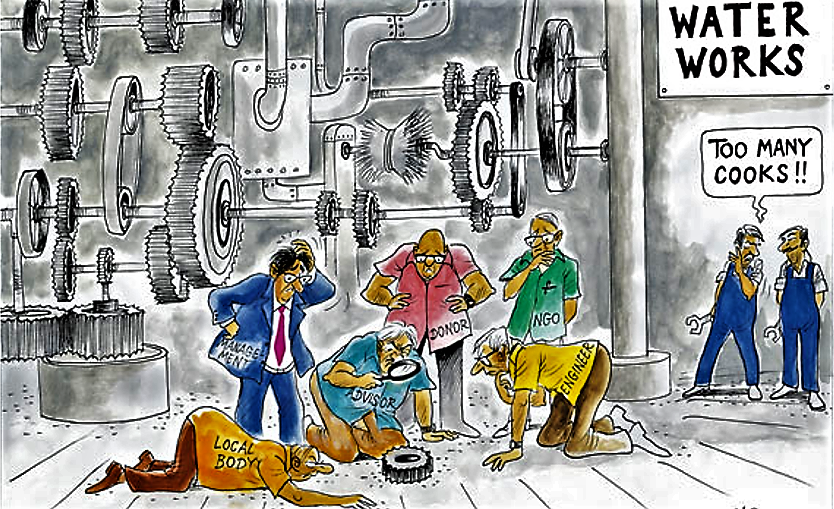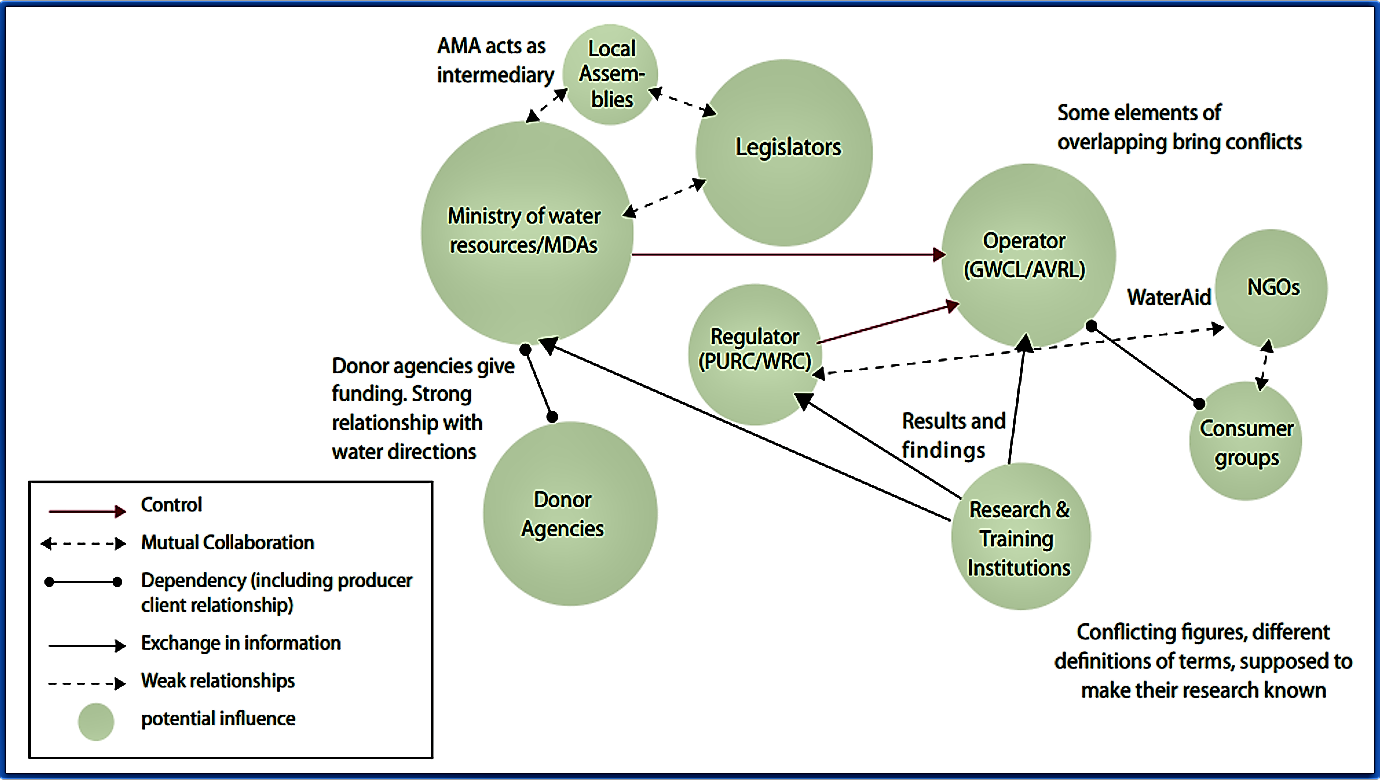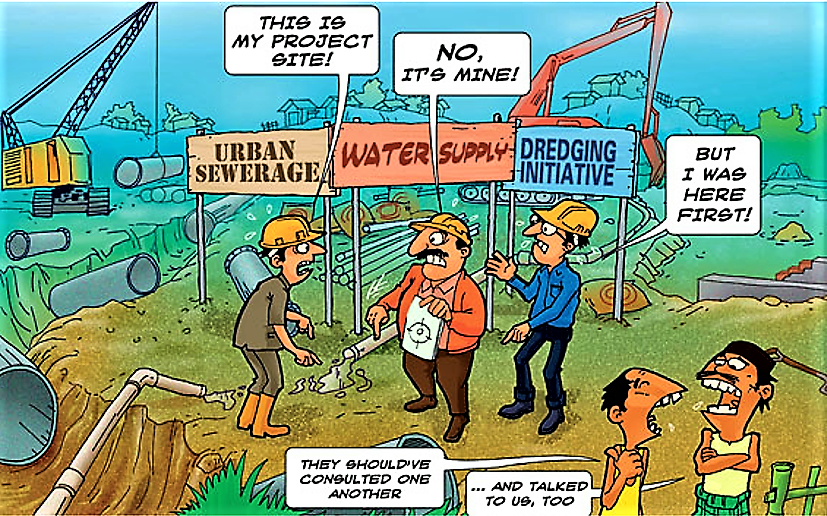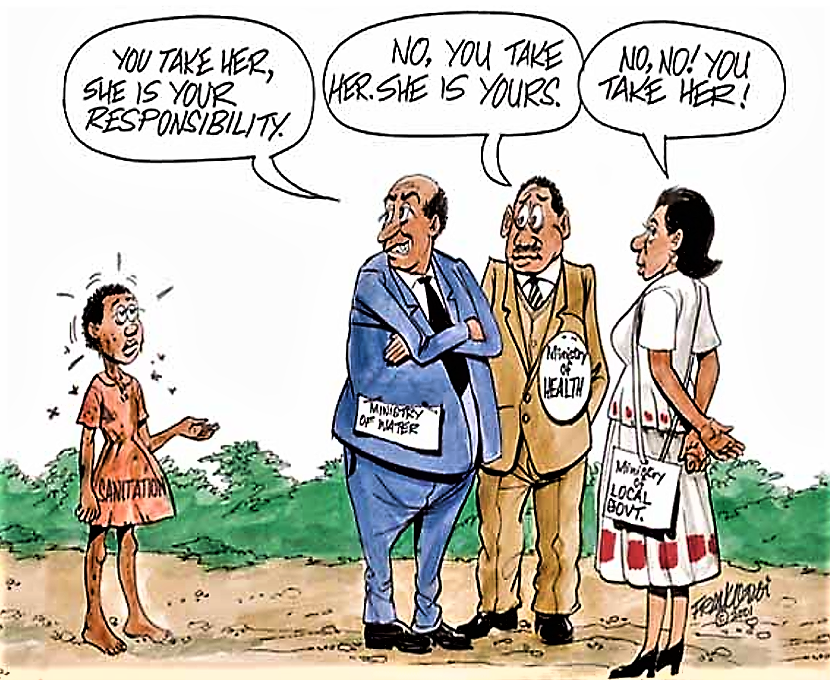The clear allocation of functions for the implementation of sustainable sanitation and water management is crucial for its outcomes. Overlapping functions and responsibilities lead to confusion, conflicts and thus to the slowdown of the process. Therefore, some existing functions and responsibilities might need to be bundled or unbundled to make sure they are well allocated and fixed in the sanitation and water management policies and in the legal framework. The goal of this factsheet is to describe how to bundle and unbundle functions and responsibilities on a local level, to make sure progress in sustainable sanitation and water management will thereby not be hampered.
For implementing sustainable sanitation and water management on the local level, the allocation of functions and responsibilities between different institutional spheres and within organisations/institutions is crucial. A clear definition of roles and responsibilities of different stakeholders decreases overlapping and therefore increases the efficiency within a project. As bundling and unbundling of functions codetermines the success of the implementation of many interventions, it is one part of building an institutional framework to enable the environment for sustainable sanitation and water management (adapted from DFID 1998). When functions and responsibilities are not set out clearly, the progress of projects will be hampered and conflicts might appear between different stakeholders. (To avoid such conflicts see also stakeholder strategy plan).
Expenditure assignment is usually shared among different levels of government, civil society, and the private sector (see also privatisation). The main question to answer is “Who does what?” (HERMANN et al. 2000). Therefore, different aspects need to be analysed: the separation between public and private functions, the relationship between central and local governments,the allocation of functions among municipalities with different capacity, as well as the function of the civil society and of the private sector.

The question “Who does what?” is not always easy to answer, and a lot of issues need to be taken into account to analyse which allocation of tasks and responsibilities is expedient. As an efficient allocation of functions depends on the capacity of different stakeholders, the financial background, the policies and legal framework and on socio cultural issues, there is no general best practice, but you will find some tips to find the best solution for your case of function allocation down below.
Make a Stakeholder Analysis
At first, all sanitation and water management stakeholders ― especially key stakeholders ― should be identified (see also stakeholder identification). Their links with each other are also important to know. Generally, a stakeholder is an agency, organisation, group or individual whose (COULBY 2009):
- Interests are affected by an issue or project
- Activities strongly affect an issue or project
- Power, money, technical expertise or organisational profile gives control over relevant implementation instruments
- Information, resources, experience or expertise is required for strategy or policy-making on an issue
As water and sanitation are both social goods (to which people have a right) and economic goods, three broad groupings need to be involved (adapted from MORIARTY et al. 2007):
- Main social groups (men, women, poorer, better-off) who have a right to water and sanitation
- Main water-user groups (farmers, domestic users, industrial users, etc.)
- Main institutional stakeholders including private sector water and sanitation providers, local NGO’s/ CBO’s, local government and politicians, legal representatives and enforcement bodies (see also strengthening enforcement bodies)
Try to make a diagram like the one down below, where you write down all stakeholders and mark their connect ions to each other.

Create a Stakeholder Platform
Invite all relevant stakeholders (representatives of each group) to a stakeholder platform to discuss the question of the allocation of sanitation and water management functions. The platform needs time to develop; maybe regular over months or even years are needed.
Identify Actual Functions
Find out the actual functions and responsibilities of each stakeholder in sustainable sanitation and water management. Make a difference between the functions and responsibilities he really holds (legal framework, contracts, unwritten laws, etc.) and the functions he thinks he holds. Note that all functions and responsibilities that might overlap or lead to confusion or conflict. This part should be done within a stakeholder platform. (For more information: stakeholder importance and influence and venn diagrams).

The function analysis can be carried out in workshops and with the actors and tasks matrix: Each row of the matrix represents a different actor involved in sanitation and water management, while each column identifies a key task and role. The matrix is filled in based on discussions with stakeholders in workshops. Afterwards, the main overlaps and gaps in the matrix can be compared and completed with the results of other groups. Some guiding questions for the workshops can be found below (MORIARTY et al. 2007):
- Which tasks/ functions are performed by which actors?
- What activities do the actors carry out in performing these tasks? How effective are they?
- What gaps are there between tasks?
- What overlaps are there between different actors/ tasks?
- Is there a coordinated effort by actors to integrate their tasks?
- What factors within the system have a positive or negative influence on task performance?
- What information is held by which stakeholders that helps them to perform their tasks? Is it shared? If so, how?

Identify Actors’ Capacities
As the key actors need the capacity to fulfil their future function/s properly, it is important to find out about their capacity, expertise and weakness and also about their resources. The potential of each stakeholder should be discussed, which can be done in workshops. The results can be discussed with other groups after the workshops have been finished. Therefore, the identified capacities and weaknesses should be summarised on flip chart papers, with mindmapping or the like.
Propose Future Functions
After finding out about capacities and weaknesses of each actor, a possible allocation of the future functions and tasks should be proposed (see also visioning, brainstorming and SWOT analysis), in dependence on overlapping and gaps defined in step 3. Key questions for the control of the new allocation of functions might be (adapted from ENGEL and SALOMON 1997):
- Do the proposed functions fall within the scope of the current activities of the actors?
- Does a relative consensus exist concerning the need to intervene and the need to carry out the interventions proposed by the team and the participating actors?
- Do the relevant key actors see the functions as being in their interest (see also stakeholder interests)
- Whose perceived interests might be negatively affected by the new allocation of functions?
- Which of the key actors share a need for the perceived interventions? If they work alone, could they make changes?
- Do the relevant key actors have the resources needed to implement the proposed interventions (financial, human, knowledge base, leadership, organisational capacities)?
- Which of the key actors has actually expressed willingness to implement some or all of the proposed interventions?
Implementation
After the steps 1-5 have been finished, the new functions need to be implemented by the stakeholders in the allocation proposed before. It is very helpful to fix the new allocation of functions in policies to avoid conflict potential. Also, the new allocation of functions should be monitored by all stakeholders, to find out about upcoming problems early.
Bundling and unbundling of functions and tasks has a very wide applicability. It can always help avoiding overlaps and gaps of functions and responsibilities and is therefore especially helpful if conflicts about functions and responsibilities exist.
A Guide to Multistakeholder Work
With its practical approach, this guide is very helpful for multi-stakeholder work in the water and sanitation sector.
COULBY, H. (2009): A Guide to Multistakeholder Work. London: The Water Dialogues (Editor) URL [Accessed: 24.04.2019]Guidance Manual on Water Supply and Sanitation Programmes
This manual has been prepared as a tool to help improve DFID's (Department for International Developments, United Kingdom) support for water supply and sanitation projects and programmes in developing countries. Its particular focus is on how DFID assistance can best meet the needs of the urban and rural poor for water supply and sanitation services.
DFID (1998): Guidance Manual on Water Supply and Sanitation Programmes. London: Water, Engineering and Development Centre (WEDC) for the Department for International Development (DFID) URL [Accessed: 09.05.2018]Facilitating Innovation for Development: A RAAKS Resource Box
Allocation of Local Government Functions: Criteria and Conditions
The EMPOWERS Approach to Water Governance: Guidelines, Methods and Tools
The guideline provides information necessary to understand the EMPOWERS approach of water governance and explains in details how to use the approach for planning and implementation of water management and related issues.
MORIARTY, P. BATCHELOR, C. ABD-ALHADI, F. LABAN, P. FAHMY, H. (2007a): INWRDAM The EMPOWERS Approach to Water Governance: Guidelines, Methods and Tools. pdf presentation. Amman, Jordan: Inter-Islamic Network on Water Resources Development and Management (INWRDAM) URL [Accessed: 18.03.2010]Too Many Cooks Spoil the Broth
Guidance Manual on Water Supply and Sanitation Programmes
This manual has been prepared as a tool to help improve DFID's (Department for International Developments, United Kingdom) support for water supply and sanitation projects and programmes in developing countries. Its particular focus is on how DFID assistance can best meet the needs of the urban and rural poor for water supply and sanitation services.
DFID (1998): Guidance Manual on Water Supply and Sanitation Programmes. London: Water, Engineering and Development Centre (WEDC) for the Department for International Development (DFID) URL [Accessed: 09.05.2018]The EMPOWERS Approach to Water Governance: Guidelines, Methods and Tools
The guideline provides information necessary to understand the EMPOWERS approach of water governance and explains in details how to use the approach for planning and implementation of water management and related issues.
MORIARTY, P. BATCHELOR, C. ABD-ALHADI, F. LABAN, P. FAHMY, H. (2007a): INWRDAM The EMPOWERS Approach to Water Governance: Guidelines, Methods and Tools. pdf presentation. Amman, Jordan: Inter-Islamic Network on Water Resources Development and Management (INWRDAM) URL [Accessed: 18.03.2010]The EMPOWERS Approach to Water Governance: Background and Key Concepts
The booklet provides an explanation of the conceptual background to the EMPOWERS approach to water governance and is a companion volume to the “EMPOWERS Approach to Water Governance: Guidelines, Methods and Tools”. It helps to develop a deeper understanding of the approach.
MORIARTY, P. BATCHELOR, C. LABAN, P. FAHMY, H. (2007b): INWRDAM The EMPOWERS Approach to Water Governance: Background and Key Concepts. Amman, Jordan: Inter-Islamic Network on Water Resources Development and Management (INWRDAM) URL [Accessed: 18.03.2010]Sanitation and Hygiene Promotion: Programming Guidance
A Guide to Multistakeholder Work
With its practical approach, this guide is very helpful for multi-stakeholder work in the water and sanitation sector.
COULBY, H. (2009): A Guide to Multistakeholder Work. London: The Water Dialogues (Editor) URL [Accessed: 24.04.2019]Too Many Cooks Spoil the Broth
KIT Royal Tropical Institute - Knowledge for a Sustainable World
On this website, some practical documents on multi-stakeholder work can be found, including many ideas how to prepare a stakeholder analysis, platform etc.


